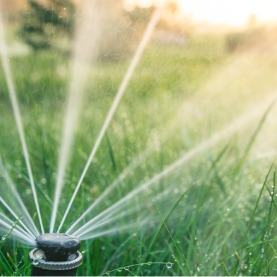
How Do I Winterize My Sprinkler System?
Nov 02nd 2023
Winterizing your sprinkler system is critical for protecting your lawn irrigation system from the cold. North Central Florida is known for its temperate climate throughout most of the year. Even so, sprinkler systems can be affected by the cold in the winter. Our water irrigation systems save us a significant amount of time and effort when it comes to cultivating and maintaining a green lawn and a vibrant, lush natural landscape. Here, our landscapers in Gainesville, FL, discuss how to winterize your lawn irrigation system to prevent damage to the system's pipes and valves.
Evergreen Lawn Care is a full-scale landscaping company in Gainesville, FL, and Jonesville, FL, offering high-quality lawn maintenance and landscaping for a beautiful property throughout every season. Contact us to request a free estimate and to learn more about our services!
Shut Off Your Main Water Valve
The first step in winterizing your lawn irrigation system is to turn off the water system on your property using the main water valve. For many properties, the main water valve is usually located near the water meter. If your sprinkler or irrigation system is equipped with valves designed to prevent water backflow, shut these off as well. These valves typically occur in twos, and both should be turned off. Systems that don't use potable water to irrigate the landscape typically do not have backflow preventer systems installed. For assistance with this process, call our Gainesville landscaping company!
Turn Off The Automatic Timer
Water irrigation systems in residential and commercial properties often run on automatic timers. In the winterization process, these automatic timers should be disabled or shut off. If your system features a rain mode in which the timer can be shut off without affecting the pre-set programmed settings, you might consider setting the timer to rain mode through the winter season. This is usually effective and will not increase your energy costs. When the winter season passes, you can switch off the rain mode and ensure the system resumes its normal functioning. If you are concerned about leaving your system running in rain mode, you might consider shutting off the timer mechanism altogether.
Drain Out The Water
Once you've shut off the system and any automated timers, you can rest assured that you've effectively prevented water from flowing into your irrigation system, but what about the water that's already in the system? That's where draining out the water comes into play. Draining the water out of your lawn irrigation system is often the most significant and time-consuming part of the winterizing process, but it is absolutely essential. Depending on the type of irrigation system you have on your property, you could use the manual, automatic, or blow-out draining process.
While you might manage the automatic and manual methods, we advise against the blow-out process, as it is potentially dangerous and can cause damage to your system. The most convenient and effective way to ensure the water is drained from your irrigation system is with the help of an irrigation professional. Call Evergreen Lawn Care today!
Automatic Draining
Automatic draining systems are equipped with valves that automatically drain water out of your pipes, but this happens only when the water pressure is below a certain level. You can usually activate the automatic drain function in your lawn irrigation system by turning off the water supply at the main valve and then running the sprinkler heads to remove water pressure within the system. At this point, the automatic draining process should commence, removing excess water from the system's pipes. You should also drain the water flowing between the system's shut-off value and backflow mechanism. If your system has check valves, you should empty them individually and separately from the other mechanisms.
Manual Draining
With systems equipped with manual draining mechanisms, you can remove excess water from your system by opening a valve. To manually drain excess water from your system, you should shut off the water supply to the irrigation system, find the manual valves at the ends of the pipes, open each valve and drain the water in the system, and drain the backflow mechanism. If your lawn irrigation system has check valves, your should attempt to raise the sprinkler heads to allow water to drain from these mechanisms. Once the entire system is drained, make sure that all of the valves are closed.
Insulate All Above-Ground Parts
Once you have shut off the water, disabled any automatic timer mechanisms, and drained the excess water from your system, it's time to insulate all above-ground components. In this step, you should ensure that all above-ground components of your lawn irrigation system are sufficiently insulated from low temperatures. You should wrap any exposed pipes, backflow preventers, and the main shut-off valve in foam covers or use insulation tape. When insulating the backflow preventers, take special care to avoid blocking any drain outlets or air vents.
